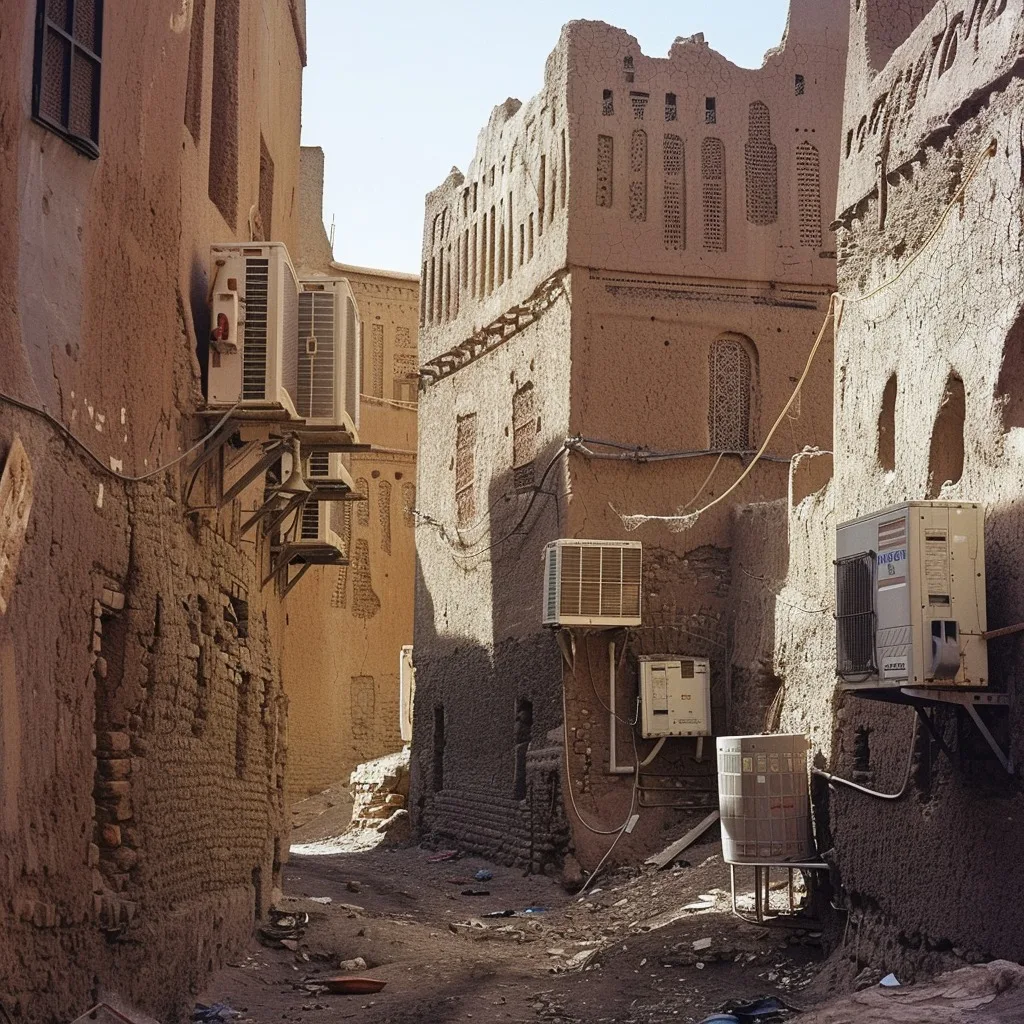Air conditioning is often associated with the modern era and the advancements in technology that have allowed us to control the temperature and humidity of our environment. However, the concept of air conditioning can be traced back to ancient times, when ingenious methods were employed to keep people cool and comfortable. In this article, we will explore the fascinating world of ancient air conditioning and discover how our ancestors found ways to beat the heat.
Understanding the concept of ancient air conditioning
Before we delve into the specifics of ancient cooling techniques, it is important to understand the underlying science behind these methods. The ancient civilizations recognized that certain materials and design principles could help regulate temperature and airflow, providing relief from the sweltering heat of summer.
The science behind natural cooling methods
One of the key principles behind ancient air conditioning was the utilization of natural elements to cool indoor spaces. In regions with hot climates, such as Egypt or India, the use of evaporative cooling was prevalent. This process involves harnessing the evaporation of water to lower the temperature of the surrounding air. By strategically placing water features such as fountains or water curtains in buildings, the air would be cooled as it passed through, creating a refreshing atmosphere.
But did you know that ancient civilizations also employed other ingenious methods to keep cool? In ancient Rome, for example, some wealthy households had underground chambers called “hypocausts.” These hypocausts were heated by a furnace and had channels running beneath the floors, walls, and even beds. The hot air from the furnace would circulate through these channels, warming the surfaces and creating a cozy environment during the colder months. However, during the scorching summers, the Romans would divert the hot air outside, allowing the chambers to remain pleasantly cool.
In addition to evaporative cooling and hypocausts, natural materials played a significant role in regulating temperature. Buildings constructed from materials with high thermal mass, such as stone or adobe, could absorb heat during the day and release it slowly during the cooler evenings. This allowed ancient civilizations to maintain a comfortable indoor environment without relying on mechanical devices.
The role of architecture in ancient cooling systems
Architecture also played a crucial role in ancient cooling systems. The design and layout of buildings were carefully planned to optimize airflow and provide shade. For instance, in ancient Egypt, buildings were often oriented to capture prevailing winds, ensuring a constant flow of cooler air. The placement of windows and openings also facilitated cross-ventilation, allowing hot air to escape and fresh air to enter.
But it wasn’t just the Egyptians who were masters of architectural ingenuity. In ancient Persia, the construction of windcatchers, known as “badgirs,” was a common practice. These tall, tower-like structures were strategically placed on rooftops to capture the slightest breeze. As the wind entered the openings at the top of the windcatcher, it would create a downward draft, pulling hot air out of the building and replacing it with cooler air from below. This natural ventilation system was a testament to the Persian’s innovative approach to staying cool in the blistering heat.
The incorporation of shading devices, such as awnings or pergolas, was another common practice in ancient architecture. These structures provided protection from direct sunlight, reducing the amount of heat that penetrated indoor spaces. By combining shading techniques with natural cooling methods, ancient civilizations were able to create indoor environments that were significantly cooler than the outside temperatures.
Early civilizations and their cooling techniques
Now that we have a deeper understanding of the science and architectural principles behind ancient air conditioning, let us explore the cooling techniques employed by early civilizations.
Ancient Egyptian methods of air conditioning
Ancient Egypt is known for its grand pyramids and monumental structures, but it is also recognized for its innovative cooling methods. The Egyptians recognized the importance of water in maintaining a comfortable environment and developed intricate systems of canals and channels to bring water into their buildings. Water from the Nile was used to irrigate gardens and flow over porous partitions called “mashrabiyas,” creating a cooling effect through evaporation.
In addition to water-based cooling, the Egyptians also utilized materials with high thermal mass, such as limestone, in their construction. The Great Pyramid of Giza, for example, was built using stones that absorbed and dissipated heat, contributing to a more comfortable interior temperature.
But did you know that the Egyptians also used natural ventilation techniques to enhance their cooling systems? They strategically placed windows and openings in their buildings to allow for cross ventilation, creating a refreshing breeze that helped combat the sweltering heat. This ingenious combination of water-based cooling, thermal mass, and natural ventilation made the ancient Egyptian buildings remarkably comfortable even in the scorching desert climate.
Cooling systems in the Roman Empire
The Romans, known for their engineering prowess, also implemented sophisticated cooling systems in their buildings. One such technique was the use of aqueducts to supply water for both bathing and cooling purposes. Water would flow through pipes embedded in the walls, imparting a cooling effect to the surrounding rooms.
But the Romans didn’t stop there. They were pioneers in the use of shade and insulation to keep their buildings cool. They constructed awnings and canopies made of fabric or plant materials to shield their homes from direct sunlight. Additionally, they used insulating materials such as straw and cork in their walls and roofs to prevent heat from penetrating the living spaces. These innovative strategies, combined with their advanced water-based cooling systems, allowed the Romans to enjoy a comfortable indoor climate even during the hottest months.
Traditional Indian architecture and its cooling mechanisms
India, with its diverse climate, relied on ingenious cooling techniques to combat the intense heat. Traditional Indian architecture incorporated features such as courtyards, verandas, and ornate screens called “jaalis.” These elements facilitated natural ventilation and reduced direct exposure to the sun while still allowing for adequate airflow.
Water played a vital role in Indian cooling methods as well. Stepwells, known as “baolis,” were common in arid regions and acted as underground reservoirs. These structures not only provided a supply of water but also offered a cool retreat from the scorching heat. The architecture of places of worship, such as temples, often incorporated water bodies and fountains to create an environment of tranquillity and coolness.
But did you know that Indian architects also employed the use of evaporative cooling? They designed buildings with features like water cascades and water curtains, where water would flow over a surface, creating a cooling effect through evaporation. This technique, combined with the strategic placement of windows and openings to promote cross ventilation, made traditional Indian buildings exceptionally cool and comfortable even in the most oppressive heat.
The evolution of air conditioning over the centuries
As time progressed, so did our understanding of cooling techniques. The Middle Ages and the Renaissance brought about a shift in cooling methods, driven by advances in engineering and a growing desire for more comfortable living spaces.
The Middle Ages and the Renaissance: A shift in cooling methods
During the Middle Ages, a form of cooling known as “passive cooling” gained prominence. This method focused on utilizing natural elements to create comfortable indoor environments. Buildings were designed with features such as thick walls, small windows to minimize heat gain, and high ceilings for better air circulation.
Interestingly, during this period, people also employed various ingenious methods to keep themselves cool. For example, in some European countries, individuals would hang wet sheets in doorways or windows to create a cooling effect as the wind blew through them. This simple yet effective technique provided a refreshing breeze and helped combat the sweltering heat.
The Renaissance period brought about a renewed interest in science and innovation, and this translated into advancements in cooling methods. The development of mechanical devices, such as fans and water-driven fans, provided a more active approach to cooling. These devices relied on human or animal power to generate airflow, aiding in the circulation of cool air.
The Industrial Revolution and its impact on air conditioning
The Industrial Revolution brought about significant changes in society and also revolutionized the world of air conditioning. With the advent of steam power and the widespread use of machinery, new possibilities for cooling emerged.
In the 19th century, inventors began experimenting with refrigeration techniques, leading to the development of mechanical cooling systems. The introduction of refrigerants and the expansion of the industrial sector allowed for the creation of large-scale cooling systems, transforming the way we controlled indoor climates.
During this time, air conditioning systems started to be used not only in residential buildings but also in public spaces. Theaters, for instance, adopted cooling systems to provide a more pleasant experience for their patrons during hot summer months. This innovation not only improved comfort but also opened up new possibilities for entertainment, as people could now enjoy performances without being overwhelmed by the heat.
Furthermore, the Industrial Revolution also brought about advancements in air conditioning technology for industrial purposes. Factories and manufacturing plants started implementing cooling systems to maintain optimal working conditions for their workers. This not only increased productivity but also improved the overall well-being of employees, ensuring a safer and more comfortable working environment.
The influence of ancient air conditioning on modern systems
While modern air conditioning systems have come a long way from the methods employed by our ancestors, there is still much to learn from the past. Ancient techniques can provide valuable insights into sustainable and energy-efficient cooling solutions.
Lessons from the past: Applying ancient techniques today
As we strive for more sustainable living, the principles of ancient air conditioning can be incorporated into contemporary designs. By utilizing natural materials with high thermal mass, designing buildings with optimal airflow, and harnessing the power of evaporative cooling, we can reduce our reliance on energy-intensive cooling systems.
One such ancient technique that has caught the attention of architects and engineers is the use of windcatchers. These ingenious structures, commonly found in ancient Persia, capture the slightest breeze and direct it into buildings, providing a natural and refreshing airflow. By integrating windcatchers into modern designs, we can enhance natural ventilation and reduce the need for mechanical cooling.
Furthermore, architects and engineers are integrating nature-inspired designs and passive cooling methods into modern buildings. Incorporating green roofs, living walls, and water features can help create a cooler and more sustainable urban environment.
The future of air conditioning: A return to natural methods?
As we face the challenges of climate change and the need for more environmentally friendly practices, there is a growing interest in returning to natural cooling methods. Ancient techniques, such as evaporative cooling and passive ventilation, offer promising alternatives to conventional air conditioning systems.
Another ancient method that is gaining attention is the use of earth tubes. These underground passages, used by ancient Romans, take advantage of the earth’s natural insulation properties to cool the air before it enters a building. By incorporating earth tubes into modern designs, we can tap into this ancient wisdom and significantly reduce the energy consumption of air conditioning systems.
The future of air conditioning might see a fusion of ancient wisdom and cutting-edge technology, combining the best of both worlds to create sustainable and comfortable indoor environments.
In conclusion, the air conditioning methods used by ancient civilizations may seem primitive compared to our modern systems, but they laid the foundation for the innovations we enjoy today. By understanding and appreciating the ingenuity of our ancestors, we can gain insights into sustainable cooling techniques and pave the way for a more eco-friendly future.

